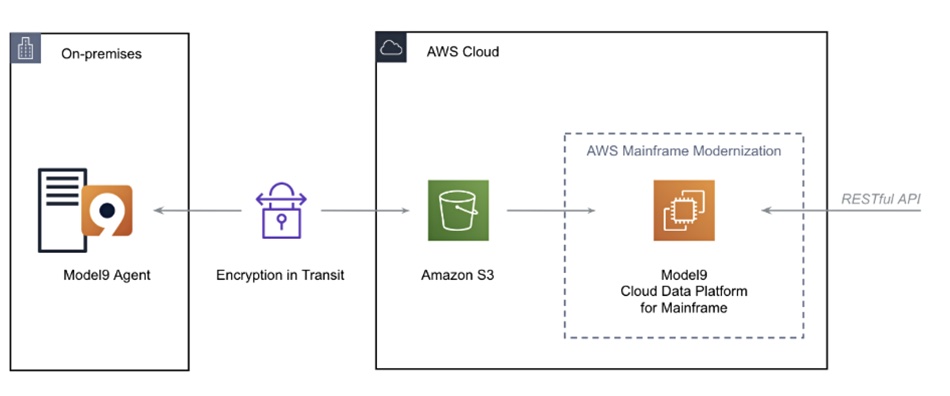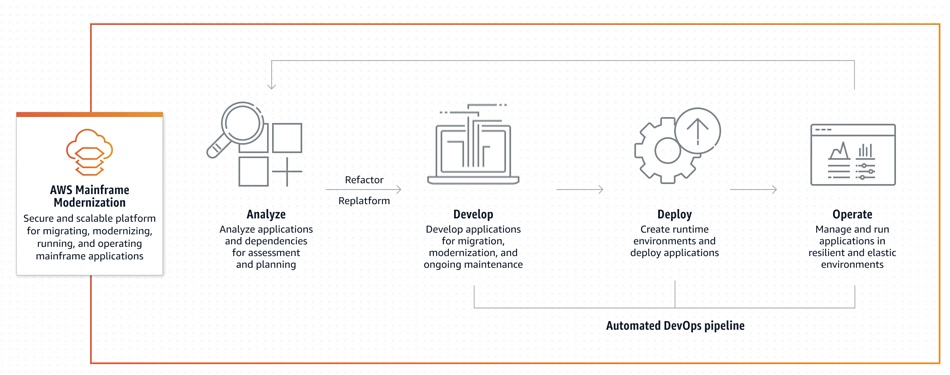AWS is using Model9 as a data pump to draw file data off mainframes and sluice it into S3 buckets as part of a wholesale mainframe modernization exercise.
This includes replatforming and converting mainframe applications so they can run on AWS, and also having Model9’s Cloud Data Platform for Mainframe be a RESTful API-accessible repository for applications and AWS services needing to use mainframe data. Model9 is supplying software technology that will be integrated into AWS’ Mainframe Modernization services.

Gil Peleg, Model9 Founder and CEO, said in a statement that, by “incorporating the Model9 File Transfer solution into AWS Mainframe Modernization, customers can move their mainframe data into Amazon Simple Storage Service (Amazon S3) and start using AWS value added services like Amazon Athena or Amazon QuickSight without impacting their mainframe environment.”
Model9’s software performs parallel IO transmission of mainframe data at scale to the public cloud or on-premises object stores, and uses IBM’s non-billable zIIP facility to process mainframe file data, meaning its mainframe compute is free.
According to IBM, mainframes hold and generate roughly 80 percent of the world’s corporate data, including both active data from applications running on mainframes as well as decades of historical data kept for regulatory compliance, archival and data protection. Mainframes still run mission critical applications at the world’s top banks, insurers, telcos, retailers, airlines, manufactures and other large enterprises.

The mainframe environment is proprietary and relatively static, with little ability to use the cloud for compute bursting or cloud-based apps to analyse mainframe data. Peleg said: “The Model9 File Transfer solution is addressing a major challenge holding back mainframe modernization initiatives of efficiently and securely migrating the vast amounts of mainframe data to the cloud from the various proprietary data formats and storage systems it is currently kept on.”
AWS Mainframe Modernization is a service for mainframe customers to migrate their workloads to an AWS managed runtime environment, and comprises a set of tools providing infrastructure and software for migrating, modernizing, and running mainframe applications in AWS.
Users can automate the process of transforming mainframe language applications into Java-based services with AWS Blu Age using web frameworks and cloud DevOps best practices.
AWS states “AWS Blu Age Refactor automatically creates modern applications from legacy monolithic mainframe or midrange source code. Applications in COBOL, generated COBOL, PL/1, NATURAL, RPG/400, COBOL/400 and their respective underlying databases and data files DB2, DB2/400, VSAM, IMS, IDMS are transformed into modern distributed applications relying on Angular, Java/Spring, PostgreSQL or other databases such as Amazon Aurora, RDS for PostgreSQL, Oracle database, IBM Db2.”

COBOL and PL/I applications can be migrated with an integrated Micro Focus toolchain. AWS says its mainframe modernization customers can set up a highly available runtime environment and use automation to deploy applications in minutes.
It has a set of partners to help mainframe users migrate; AWS not having the competencies needed itself, and the list includes Accenture, Atos. Deloitte and others.
Ilia Gilderman, general manager for Migration Services at AWS, said: “Data is a core asset of any modernization project. Connecting Model9 capabilities directly to AWS Mainframe Modernization will allow customers to move data quickly and securely, with minimal domain expertise.”
He reckons AWS’ Mainframe Modernization service gives AWS customers a single overall process “for simplifying and accelerating the migration and modernization of mainframes to the cloud.”
We understand from people familiar with the situation that the Model9-AWS deal is at a significant, very significant, dollar level, and runs for more than five years. This is a first for any Israeli company and possibly a first for any company partnering with AWS.
Read a short AWS Mainframe Modernization FAQ to find out not much more. In fact there is much more detailed information on the AWS Mainframe Modernization webpages and you can talk to one of AWS’ partners to get a deeper understanding of what’s involved.








